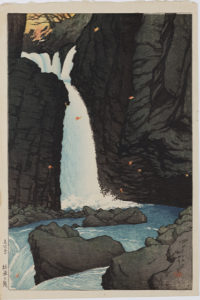In Falling Water, Soaring Kites the Morikami Museum explores the idea of transformative experiences by highlighting two aspects of Japanese culture that have inspired devotion to ritual, profound poetry, and sublime paintings since the tenth century: the veneration of waterfalls and the art of the humble kite. These seemingly disparate phenomena are actually connected through deeply felt belief systems that include a world of animate and inanimate objects inhabited by the gods. To stand in awe of a vertical wall of water one hundred meters tall or watch with joy as a beautifully decorated kite dances and soars ever higher captures the imagination and holds promise for a transcendent moment, both physical and spiritual. Drawn from the Museum’s Permanent Collection, this exhibition features a selection of 19th and 20th century prints, paintings, and lacquerware depicting celebrated waterfalls accompanied by a delightful array of bold, colorful kites.
Beginning in the 18th century, the increased economic stability of most Japanese citizens, especially in vibrant urban centers like Edo (Tokyo), resulted in a growing participation in entertaining past times and the ability for domestic travel to Japan’s most scenic and sacred landscapes. Waterfalls, a prominent natural feature of Japan’s mountainous islands, have long been associated with religious worship. In a tradition dating to the Heian period (794-1185), ascetic priests sit beneath the frigid falls just before the New Year. Such austere practice is believed to facilitate access to the spirit world and mediate the activities of the divine spirits in the temporal world. The sound of water is thought to sharpen consciousness. The “shape” of water – an element in constant motion despite its confines – reflects the transient nature of life. With the development of tourism, more and more Japanese could find respite from the heat in the cooling waters of these majestic cascades, as well as seek communion with the resident deities.
Like many art forms during the Edo period (1600-1868), kite design and kite-flying reached extraordinary heights of sophistication. Part of religious and ceremonial rites for centuries, the pleasure of kite-flying eventually became integrated into secular events and fierce kite-fighting competitions. The kite was introduced to Japan through Buddhist practices brought over from China and Korea. In Buddhist and Shinto rituals, kites were flown as divinations to predict weather and to protect the success of a harvest. Congratulatory kites decorated with images of folk heroes or famous warriors were given to the parents of a first-born son. New Year’s kites still fill the skies as a symbol of thanks for the benevolence of the gods in the past year and hope in the upcoming year. Popular images include cranes and tortoises, associated with longevity, and Daruma, the patriarch of Zen Buddhism.
Traditional Japanese kites, called tako, are built in an incredible range of size, from tiny kite-shaped amulets given at shrines to giant kites up to fifty feet across and raised in festivals. In the 17th century, these great kites were rigged to lift tiles up to the roof of great temples and stories abound of daring air born robberies and escapes with the aid of giant kites. Early references to kites as kami tobi, or paper hawks, suggest that they were initially shaped like birds. This explains the enduring fondness of kites depicting birds and insects, creatures not bound to the terrestrial world. One of the most auspicious images depicted on kites is that of a carp struggling to scale a cascading waterfall, a metaphor for perseverance in the face of seemingly insurmountable obstacles.
